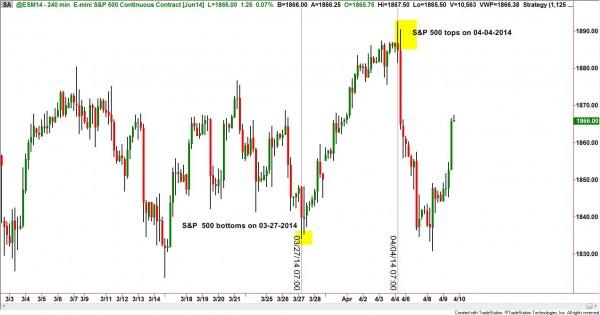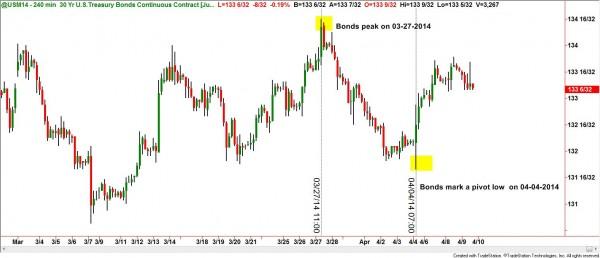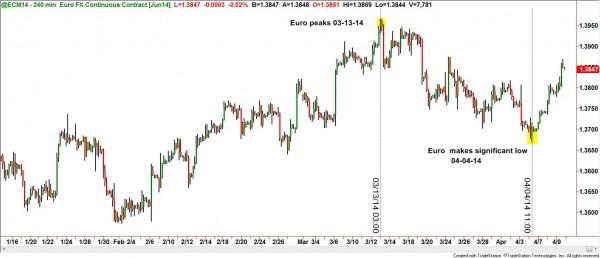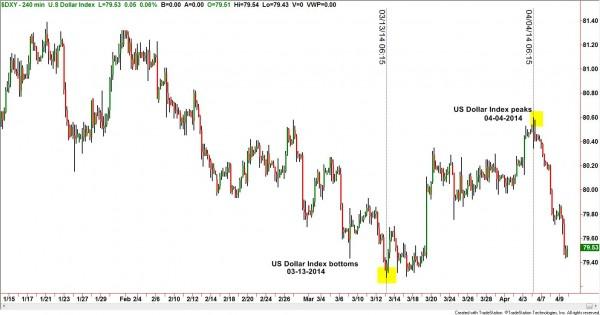Each day the global financial markets are impacted by events that cause traders to react in dramatic fashion. These responses quite often will have a ripple effect that can stretch across all types of markets and asset classes. In other words, what happens in one market will in turn move another related market. For newer traders it’s important to understand this relationship. In this missive I’ll go over some of the strongest inverse correlations, and their uses to help traders gain an edge.
But before we get started, there is one major caveat about this topic: correlations usually hold, however, there are times when what seemed to be a strong correlation between two markets breaks and it longer works. This is often a temporary phenomenon as strong correlations always revert back. An astute trader must be attune to these changes and be flexible enough to make the adjustments necessary to keep his edge.
The first inverse correlation we’ll go over is the one between stocks and bonds. For stocks we’ll use the ES (S&P 500 mini) against the (US) 30 year treasury bond futures contract to do the analysis. This is a simple risk-on versus risk-off correlation. What is meant by this is that theoretically, stocks are inherently riskier than bonds and therefore when stocks are moving higher investors generally have a bigger appetite for risk and would sell the lower yielding bond market. This changes however when things get rough in the stock market. Investors seek the safe harbor of treasuries, and in order to raise the cash necessary to purchase these fixed yielding instruments,they sell their stock holdings. The two annotated charts below illustrate these inverse correlations
We can see that major inverse moves happened pretty regularly in these two asset classes. The key for traders is to find both markets enter opposing levels simultaneously, thus increasing the probabilities of timing the turning points. This correlation is important for traders who engage the markets on an intermediate -term time frame as it can be a major odds enhancers. Identifying the quality supply and demand levels is the most important element of this equation.
The last inverse correlation we’ll look at is that of the US Dollar index against the Euro Currency. This is a very strong inverse correlation because of how the Dollar Index is comprised, and the way the currency futures contracts are traded. First, the Dollar index is a basket of currencies traded against the US Dollar. The biggest component of this index is the Euro currency constituting over 57% of the index. In addition, currencies futures are only the major global currencies relative to the US dollar. Because of this, the moves in the Euro currency greatly impacts the Dollar index. Similar to the Stock -Bond inverse correlation we can see on the charts below that all the major moves happened on the same day.
For traders trying to gain an edge, learning how different markets impact each other is a must. Not knowing how the US Dollar can change the trajectory of commodities such as oil, copper, or gold is a big disadvantage, especially when you’re competing with large banks and institutions who wouldn’t think of putting their traders on the front lines if they didn’t understand how these markets impact one another. If you want to have a chance to compete successfully you need to start thinking and acting like them, and part of this, is gaining an understanding of the interrelationships between markets. My hope is that at least this is a good starting point.
Until next time, hope everyone has a great week.
This content is intended to provide educational information only. This information should not be construed as individual or customized legal, tax, financial or investment services. As each individual's situation is unique, a qualified professional should be consulted before making legal, tax, financial and investment decisions. The educational information provided in this article does not comprise any course or a part of any course that may be used as an educational credit for any certification purpose and will not prepare any User to be accredited for any licenses in any industry and will not prepare any User to get a job. Reproduced by permission from OTAcademy.com click here for Terms of Use: https://www.otacademy.com/about/terms
Editors’ Picks
EUR/USD eases to near 1.0700 ahead of German inflation data

EUR/USD is paring gains to near 1.0700 in the European session on Monday. The pair stays supported by a softer US Dollar, courtesy of the USD/JPY sell-off and a risk-friendly market environment. Germany's inflation data is next in focus.
USD/JPY recovers after testing 154.50 on likely Japanese intervention

USD/JPY is recovering ground after sliding to 154.50 on what seemed like a Japanese FX intervention. The Yen tumbled in early trades amid news that Japan's PM lost 3 key seats in the by-election. Focus shifts to the US employment data and the Fed decision later this week.
Gold price holds steady above $2,335, bulls seem reluctant amid reduced Fed rate cut bets

Gold price (XAU/USD) attracts some buyers near the $2,320 area and turns positive for the third successive day on Monday, albeit the intraday uptick lacks bullish conviction.
Ripple CTO shares take on ETHgate controversy, XRP holders await SEC opposition brief filing

Ripple loses all gains from the past seven days, trading at $0.50 early on Monday. XRP holders have their eyes peeled for the Securities and Exchange Commission filing of opposition brief to Ripple’s motion to strike expert testimony.
Week ahead: FOMC and jobs data in sight

May kicks off with the Federal Open Market Committee meeting and will be one to watch, scheduled to make the airwaves on Wednesday. It’s pretty much a sealed deal for a no-change decision at this week’s meeting.
RECOMMENDED LESSONS
Making money in forex is easy if you know how the bankers trade!
Discover how to make money in forex is easy if you know how the bankers trade!
5 Forex News Events You Need To Know
In the fast moving world of currency markets, it is extremely important for new traders to know the list of important forex news...
Top 10 Chart Patterns Every Trader Should Know
Chart patterns are one of the most effective trading tools for a trader. They are pure price-action, and form on the basis of underlying buying and...
7 Ways to Avoid Forex Scams
The forex industry is recently seeing more and more scams. Here are 7 ways to avoid losing your money in such scams: Forex scams are becoming frequent. Michael Greenberg reports on luxurious expenses, including a submarine bought from the money taken from forex traders. Here’s another report of a forex fraud. So, how can we avoid falling in such forex scams?
What Are the 10 Fatal Mistakes Traders Make
Trading is exciting. Trading is hard. Trading is extremely hard. Some say that it takes more than 10,000 hours to master. Others believe that trading is the way to quick riches. They might be both wrong. What is important to know that no matter how experienced you are, mistakes will be part of the trading process.




